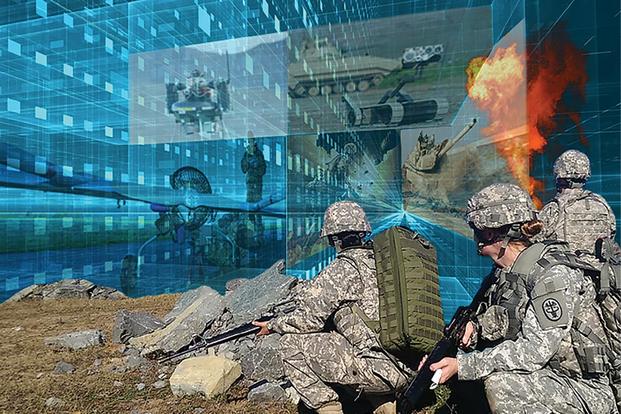A new bipartisan congressional report calls for the Defense Department to get a lot more serious about the race to acquire artificial intelligence and autonomous capabilities, modeling efforts to become dominant in these spheres after the "Manhattan Project" initiative to test and develop nuclear weapons in the 1940s.
On Tuesday, the House Armed Services Committee released the results of a yearlong review, co-led by Reps. Seth Moulton, D-Mass., and Jim Banks, R-Ind., aimed at assessing U.S. military capabilities and preparedness to meet current threats. The 87-page Future of Defense Task Force Report contains some expected findings -- China and Russia are identified as the top security threats to the U.S. and modernization is described as an urgent need -- but there are surprising points of emphasis.
Read Next: It's Raining Blood: Air Force Tests New Way to Resupply Battlefield Medics
The report leans hard into technological development and growth, particularly in the fields of machine learning and autonomy, going so far as to call for the Defense Department to evaluate an AI or autonomous alternative prior to every major future defense buy. And it also calls for the military to treat these technologies like a game-changing new weapon, establishing clear rules of the road and guardrails for their use.
"Using the Manhattan Project as a model, the United States must undertake and win the artificial intelligence race by leading in the invention and deployment of AI while establishing the standards for its public and private use," the report's authors wrote. "Although the Department of Defense has increased investment in AI and established the Joint Artificial Intelligence Center to assist with the transition and deployment of AI capabilities, cultural resistance to its wider adoption remains. Congress and the Department of Defense must take additional action to overcome these barriers."
The Manhattan Project, undertaken from 1942 to 1947, was a U.S.-led effort to obtain and test a nuclear bomb, a world-changing enterprise that led to the bombings of Hiroshima and Nagasaki, Japan, at the end of World War II.
The task force report emphasizes that, now as then, the United States is against the clock to obtain and master tools that could make or break future dominance. It noted that China has publicly set the goal of becoming the world's leading AI power by 2030, just a decade from now.
In addition to considering AI or autonomous alternatives for new DoD acquisitions, the task force recommended that the Pentagon be required to make all new major purchases AI-ready and able to "nest with existing and planned joint all-domain command and control networks." It also called for the DoD to be given greater authority to evaluate advanced technologies that might accomplish military objectives better and at a lower cost.
To back up this push for innovation, the task force called for a requirement that the military services each spend at least 1% of their budgets on the integration of new technology.
In concert with this effort, the task force said, the U.S. should lead efforts to draft and approve an international treaty with rules for the civilian and military use of AI. That treaty, it said, should be "in the vein of the Geneva Conventions, the Chemical Weapons Convention, and the Nuclear Non-Proliferation Treaty," with a goal of having all nations that plan to develop and use AI sign on.
As the U.S. military invests in leap-ahead technologies, it must also divest aggressively from old and outdated programs, the task force said. In 2030, the report's authors noted, a "staggering" 70% of military capabilities will still consist of legacy systems, according to current projections.
To cut all the dead weight, the lawmakers recommended that Congress commission Rand Corp. or a similar organization to study existing legacy platforms and determine their continued relevance over the next half-century.
"Following completion of the studies, a panel should be convened, comprising Congress, the Department of Defense, and representatives from the industrial base, to make recommendations on which platforms should be retired, replaced or recapitalized," they said.
And along with technology, the task force said, the military must modernize its aging personnel policies and infrastructure and attract fresh talent. It incorporated some of the recent recommendations from the National Commission on Military, National and Public Service, calling for more volunteer opportunities; greater incentives for military service, including student loan deferment and forgiveness; and the creation of paid year-of-service programs -- military, civilian and private-sector -- for young people.
"Although the U.S. military personnel system produces outstanding leaders, it must grow its ability to produce more service members with expanded capabilities to meet emerging threats," the task force wrote. "History repeatedly shows that technological superiority does not guarantee victory and that new ways of thinking can be more powerful than new weapons.
"Future leaders and strategists will need to embrace emerging warfighting concepts such as joint and multi-domain warfare. They will further need a comprehensive understanding of national power and how to integrate military tools into a whole-of-government effort," it added.
-- Hope Hodge Seck can be reached at hope.seck@military.com. Follow her on Twitter at @HopeSeck.
Related: Artificial Intelligence Could Soon Change How You Enlist and Transition













